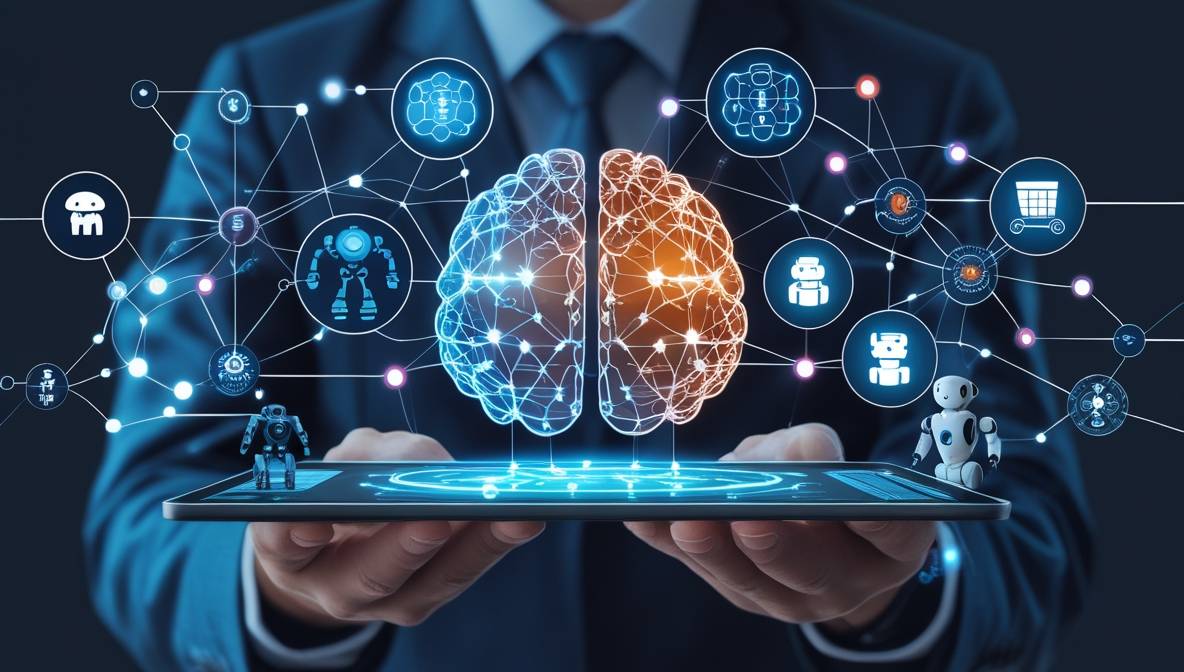Artificial Intelligence (AI) in 2025 is driving transformative changes across industries, from gaming and healthcare to national security and scientific research. With breakthroughs in model performance, emerging trends in hardware competition, and innovative applications reshaping daily life, AI is at the forefront of technological evolution. This article explores the top AI news of 2025, detailing key trends, significant breakthroughs, and their implications for the future, while addressing challenges like sustainability and regulation.
Key AI Trends Shaping 2025
Generative Virtual Playgrounds
AI is revolutionizing the creation of virtual environments, particularly in gaming. Google DeepMind’s Genie and Genie 2 models generate entire game worlds from scratch, offering immersive experiences for players (Google DeepMind). Startups like World Labs are developing large world models (LWMs) that simulate realistic scenarios, aiding in spatial intelligence and robotics training (World Labs). These virtual playgrounds are not only enhancing entertainment but also serving as testing grounds for AI systems in dynamic settings.
Large Language Models with Reasoning
Large language models (LLMs) in 2025 are incorporating reasoning capabilities, improving their ability to handle complex tasks. OpenAI’s o1 and o3 models use a “chain of thought” approach, breaking down problems into steps to enhance accuracy in mathematics, physics, and logic (OpenAI o1). Google DeepMind’s Mariner agent and Gemini 2.0 Flash Thinking also demonstrate this trend, making AI more reliable and explainable (Gemini 2.0). This shift is critical for applications requiring precision and transparency.
AI in Scientific Discovery
AI is accelerating scientific progress, with notable achievements in 2025. Google DeepMind’s AlphaFold, which won a Nobel Prize, has transformed protein structure prediction, aiding drug discovery (AlphaFold Nobel). Meta’s release of extensive datasets is fueling AI-driven materials science, while Hugging Face and Entalpic’s LeMaterial project explores new materials (LeMaterial). OpenAI’s o1 model is also contributing to research, showcasing AI’s potential to tackle complex scientific challenges (Nature).
AI and National Security
AI’s role in national security is expanding, with applications in border surveillance and intelligence. The U.S. military’s $1 billion Replicator program highlights this trend, as does OpenAI’s partnership with Anduril for defense applications (Anduril Partnership). These developments raise ethical concerns about privacy and autonomy, prompting calls for responsible AI governance (OpenAI Security).
Competition in the AI Chip Market
Nvidia’s dominance in AI chips is being challenged by companies like Amazon, Broadcom, and AMD, which are investing in custom silicon. Startups like Groq are exploring novel architectures to compete (Chip Competition). Geopolitical factors, including the U.S. CHIPS Act and potential tariffs on Taiwan’s TSMC, are shaping the global AI hardware landscape (Taiwan Tariffs). This competition is driving innovation but also highlighting supply chain vulnerabilities.
| Trend | Key Players | Impact |
|---|---|---|
| Generative Virtual Playgrounds | Google DeepMind, World Labs | Enhances gaming and robotics training |
| Reasoning LLMs | OpenAI, Google DeepMind | Improves accuracy in complex tasks |
| AI in Science | Google DeepMind, Meta, Hugging Face | Accelerates discoveries in biology and materials |
| National Security | OpenAI, Anduril, U.S. Military | Raises ethical and privacy concerns |
| Chip Competition | Amazon, Broadcom, AMD, Groq | Drives innovation in AI hardware |
Major AI Breakthroughs in 2025
U.S. Leadership in AI Models
The U.S. continues to lead in AI model development, releasing 40 notable models in 2024 compared to 15 from China and 3 from Europe (all from France) (Epoch Dataset). This dominance underscores the U.S.’s role in shaping AI’s global trajectory, though competition is intensifying.
Rising Training Costs vs. Falling Inference Costs
Training AI models is increasingly expensive, with Gemini 1.0 Ultra costing an estimated $192 million. In contrast, inference costs are dropping significantly, with GPT-3.5’s cost per million tokens falling from $20 to $0.07 and GPT-4’s from $15 to $0.12 between 2022 and 2024. This trend makes AI more accessible for end-users while posing economic challenges for developers.
AI’s Carbon Footprint
The environmental impact of AI is a growing concern. Training Meta’s Llama 3.1 model emitted 8,930 tonnes of CO2, equivalent to the annual emissions of 496 Americans. This highlights the need for sustainable AI practices, such as energy-efficient algorithms and renewable energy sources.
China’s Closing Performance Gap
Chinese AI models are rapidly catching up, with the performance gap in chatbot benchmarks narrowing from 9.26% in January 2024 to 1.70% by February 2025. Models like Manus and DeepSeek are rivaling U.S. counterparts, signaling a more competitive global AI landscape (Crescendo AI).
New AI Benchmarks
New benchmarks like Humanity’s Last Exam are pushing AI capabilities, with even advanced models like OpenAI’s o1 achieving only 8.8% accuracy (Last Exam). These benchmarks are critical for driving innovation and ensuring AI can handle complex tasks.
| Breakthrough | Details | Impact |
|---|---|---|
| U.S. Leadership | 40 models in 2024 | Maintains global AI dominance |
| Training vs. Inference Costs | High training costs, low inference costs | Balances development and accessibility |
| Carbon Footprint | 8,930 tonnes CO2 for Llama 3.1 | Raises sustainability concerns |
| China’s Progress | Performance gap narrows to 1.70% | Increases global competition |
| New Benchmarks | Humanity’s Last Exam challenges AI | Drives innovation |
AI Across Sectors
AI in Medicine
AI is transforming healthcare, particularly in diagnostics. GPT-4 has outperformed human physicians in certain tasks, and OpenAI’s o1 achieved 96% accuracy on the MedQA benchmark. However, human-AI teams sometimes underperform, indicating a need for better collaboration strategies. For more on healthcare innovations, see Recent Innovations in Machine Learning.
Corporate Investment and ROI
Corporate investment in AI reached $150 billion in 2024, with $33 billion in generative AI. However, ROI remains modest, with cost reductions under 10% and revenue increases under 5% (McKinsey Survey). This suggests that while AI’s potential is vast, implementation challenges persist. For financial insights, explore Understanding Home Loans.
Data Restriction Trends
Data access is becoming a hurdle, with 48% of top Web domains restricting scraping for AI training by 2024. This trend complicates model development and raises questions about data ownership and privacy, impacting the future of AI research.
Policy and Public Opinion
U.S. Policy Shifts to States
AI regulation in the U.S. is shifting to the state level, with 131 of 221 proposed AI bills passing in 2024 at the state level, compared to just 4 federally. States are addressing issues like deepfakes, with 56 bills introduced, reflecting a decentralized approach to AI governance.
Public Opinion on AI’s Job Impact
A global survey across 32 countries found that 60% of respondents believe AI will change jobs, while 36% expect job replacement. This mixed perception highlights AI’s transformative potential and the need for workforce adaptation strategies. For related insights, check How to Apply for a Scholarship.
Looking Ahead
The AI landscape in 2025 is dynamic, with breakthroughs and trends driving innovation across sectors. However, challenges like sustainability, data restrictions, and ethical concerns require careful navigation. As AI integrates further into society, stakeholders must prioritize responsible development to maximize benefits while minimizing risks. Stay updated with AI News Today and explore related topics like Ethereum 2.0 Update or Bitcoin Price Surges.
Other Helpfull Links
- Google DeepMind’s Genie Model for Game Creation
- World Labs’ Generative AI for Video Games
- OpenAI’s o1 Model Reasoning Capabilities
- Google DeepMind’s Nobel Prize for AlphaFold
- Hugging Face’s LeMaterial Project
- Nature: AI in Scientific Research
- OpenAI’s Defense Contract with Anduril
- OpenAI’s Approach to AI and National Security
- ASML’s Role in Chipmaking Competition
- Reuters: Taiwan’s Response to Trump Tariffs
- Epoch Dataset on Notable AI Models
- Humanity’s Last Exam AI Benchmark
- Stanford HAI’s 2025 AI Index Report
- IEEE Spectrum: State of AI in 2025
- Crescendo AI: Latest AI News and Updates
- Sundar Pichai’s X Post on Gemini 2.0

